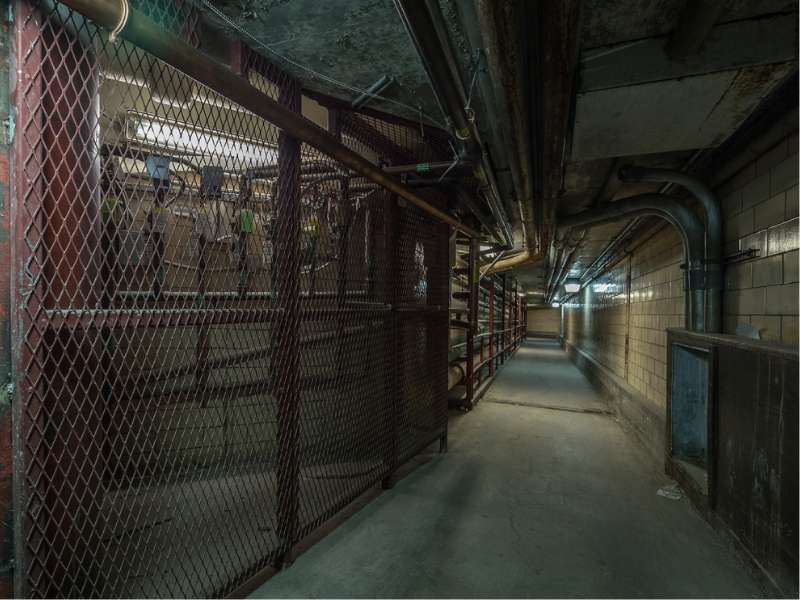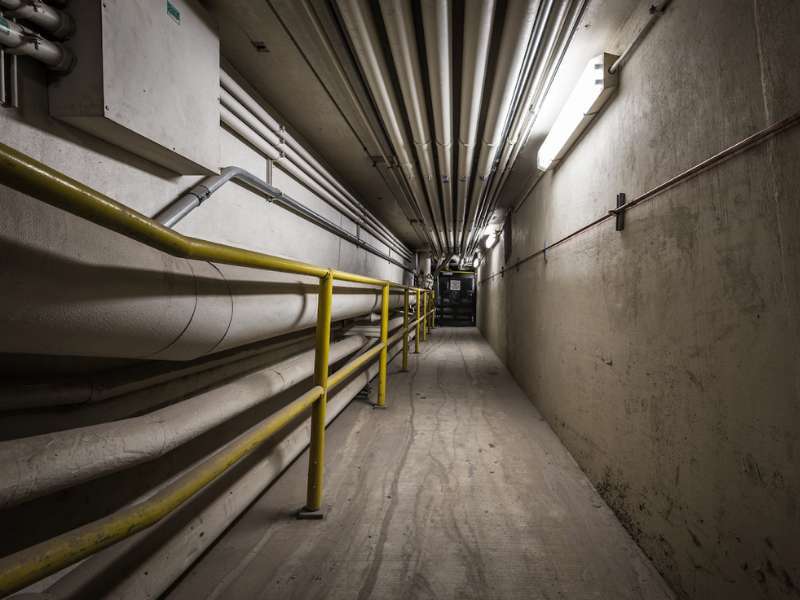Beneath these crowded streets
July 12, 2023

A network of tunnels connecting the Virginia Capitol to the Executive Mansion, other state buildings and a number of VCU Medical Center buildings (then Medical College of Virginia) was built from 1913 to 1940. It housed steam pipes and electrical wiring that heated and powered the VCU Medical Center, but had the additional benefit of acting as underground passage for state workers, doctors and nurses. The tunnels are now closed to the public.
Despite the claustrophobia-inducing, eerie conditions, many VCU School of Nursing alumni and MCV-campus pedestrians were frequent travelers in the tunnels. For those who never experienced the tunnel environs, it is easy to imagine the sounds of steam rattling through long stretches of pipes, a constant visual disturbance from flickering overhead lights, not to mention the need to politely but quickly move by fellow travelers in narrow confines.
But, in hearing from dozens of alumni and others who shared their tunnel stories, a full range of experiences came through–some humorous, some tragic, and, yes predictably, some rather haunting.
Many tunnel travelers relished the conveniences of avoiding street-level traffic and uneven cobblestones. Nursing alum Barbara Dunn (BS ‘70) recalled their practicality. “I remember them well—sort of creepy but nice and warm. And they got you where you needed to go faster and safer than above ground. In 1979 I was temporarily in a wheelchair—the tunnels were the best way to get from Sanger [Hall] basement level–where I parked–to North Hospital for physical therapy.”
Others described using the tunnels more reluctantly and cautiously, traveling in groups to transport bodies to the hospital basement morgue and autopsy room. Nursing alum Towana Worrell (B.S. ‘03) remembers a heart-breaking moment when the tunnels offered refuge for her and her colleagues in a difficult moment. “I remember caring for a child on the pediatric floor. She passed away from cancer. Transport would only take patients to the morgue if they were in the bag. Mom could not leave her child, understandably. I refused to put her child in a bag while she was present. Transport left and I gave mom all the time she needed. My coworkers and I, with tears in our eyes, ended up going through these tunnels carrying our precious angel to the morgue. I will never forget,” said Worrell.
They were definitely creepy, dark and there were lots of weird noises. I’m assuming they came from all the pipes but being that the Nursing Education Building was located next door to the Monumental Church, I couldn’t really be sure.
Erica Gregory
Many described the tunnels with an oxymoronic association, equal parts fondness and fear. And that’s certainly understandable–the tunnels also provided access to the crypt under Monumental Church where victims of the 1811 Richmond Theater fire are entombed. Erica Gregory (B.S. ‘03, M.B.A. ’10), an information systems and business administration alum and current data manager for the Office of Research, Scholarship and Innovation in the School of Nursing, remembered walking the tunnels mostly out of convenience. “I started working in the old Nursing Education Building (NEB) which was located at 1220 East Broad Street back in 2000. One of my favorite things about working at the NEB was the access to the tunnels! They were definitely creepy, dark and there were lots of weird noises. I’m assuming they came from all the pipes but being that the NEB was located next door to the Monumental Church, I couldn’t really be sure. I was always baffled that whenever I used the tunnels, I wouldn’t see anyone else down there. So every time I’d get to an intersection, I would timidly peek around the corners not knowing what to expect. Once I reached my destination door, I would always turn and look behind me,” she said.
Some who used the tunnels likened their experience to that of an explorer or adventurer. Jim Agnew, who at one time was employed with the MCV neurosurgery as a “computer geek,” remembered following his curiosity to a surprising destination. “Neuro[logy] loaned me to Vernon Williams, who was in charge of stringing cables to offices that needed to connect to Academic Computing East, or the VAX computer center. So I spent a few weeks rummaging around pulling cable through pipes with Vernon helping people go from card decks to online working… Oh, I found a tunnel door open, and followed it to where I could look up thru the vents and see the end of the old State Library, and wound up coming out at an outside door of the Capital!”


Others who shared stories, spoke of the need to reassure tunnel newcomers who looked stunned to find themselves in such a strange place. Nursing alum Holly Porter (B.S. ’82) recalled ferrying bewildered patients between services. “I have always been amazed at the literal maze of tunnels that still exists deep under the streets around VCU Health. Even lesser known these days is that the Richmond Eye & Ear Hospital (REEH) established in 1956, used to be located at 401 N. 12th Street (approximately where [Medical Center] Gateway and the Smith [VCU School of] Pharmacy building are now located), before it became the ‘mirror building’ at 1001 E. Marshall Street 1980-2002. I started working as a Nursing Assistant at REEH in the 1970s while I was still in high school. It was an independent hospital but affiliated with MCV in some ways. We had a number of Neuro-Ophthalmology patients who were admitted by MCV physicians to REEH but who underwent diagnostic testing in the radiology department at MCV. These patients were transported via wheelchair or stretcher through the tunnel that was linked from REEH’s sub-basement to West Hospital’s sub-basement. I always apologized when I had to wheel someone through those creepy-looking tunnels lined with steam pipes. I’m sure they wondered where on earth I was taking them!”
I have always been amazed at the literal maze of tunnels that still exists deep under the streets around VCU Health [...] I always apologized when I had to wheel someone through those creepy-looking tunnels lined with steam pipes. I’m sure they wondered where on earth I was taking them!
Holly Porter
Several alum, like Jane Mendez (B.S. ‘70), shared vivid memories of moments with patients in the tunnels. “Back in the early 1970’s, I received my first ‘steam facials’ traversing those tunnels from St. Phillips L&D to the NICU in North Hospital. Pediatrics would respond to our request for newborn evaluations, and if the baby needed to be transported, a nurse always accompanied the doctor to the NICU so that she could bring the ‘buggy’ back. Nothing sophisticated like the Cadillac incubators of today, but functional enough, providing O2. We also used the tunnels to transport active, laboring women to the main hospital Labor and Delivery if they needed more advanced care or an emergency cesarean section. That was a sight to behold. I assisted in three ‘tunnel births.’ The ambient temperature was warm and steamy, so the babies never got hypothermic. And, as far as I know, we all lived through it.”
Unquestionably, the MCV tunnels elicit strong memories, generously layered with sensory detail and description by those who traversed the dimly lit and damp corridors. With over a century of history, those now-abandoned passageways still contain multitudes.